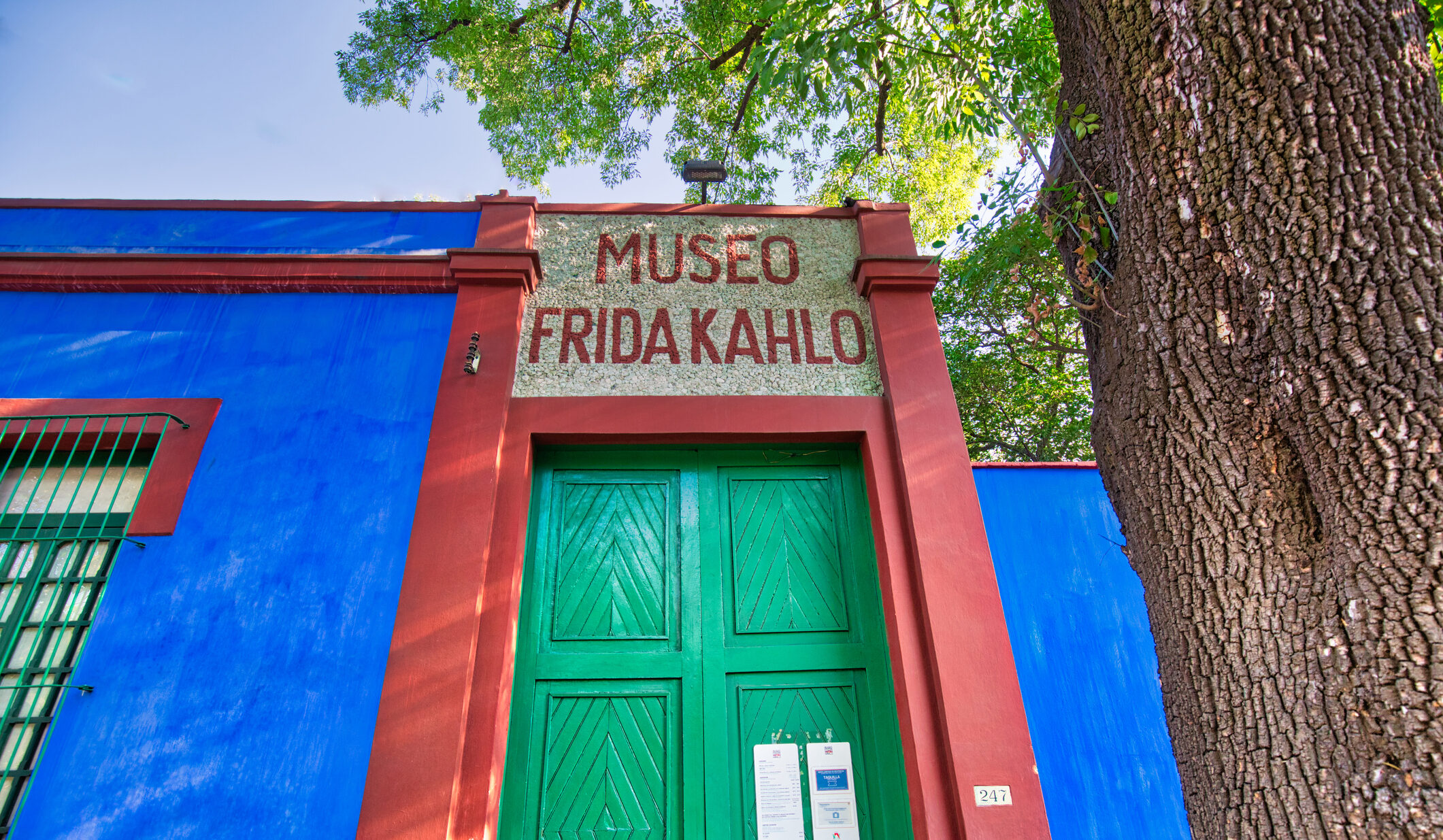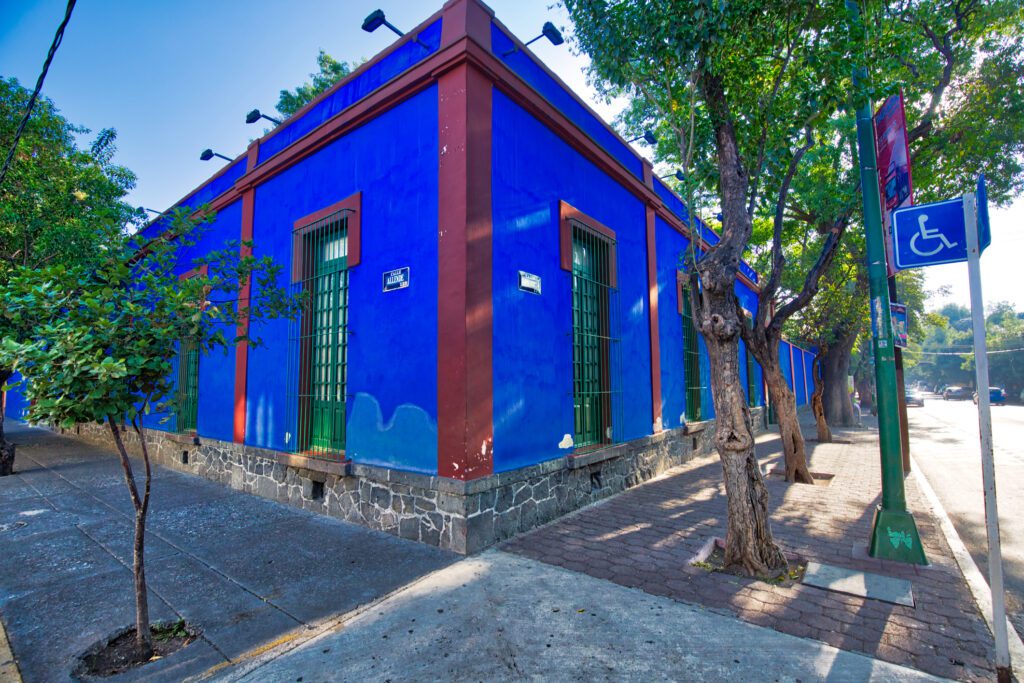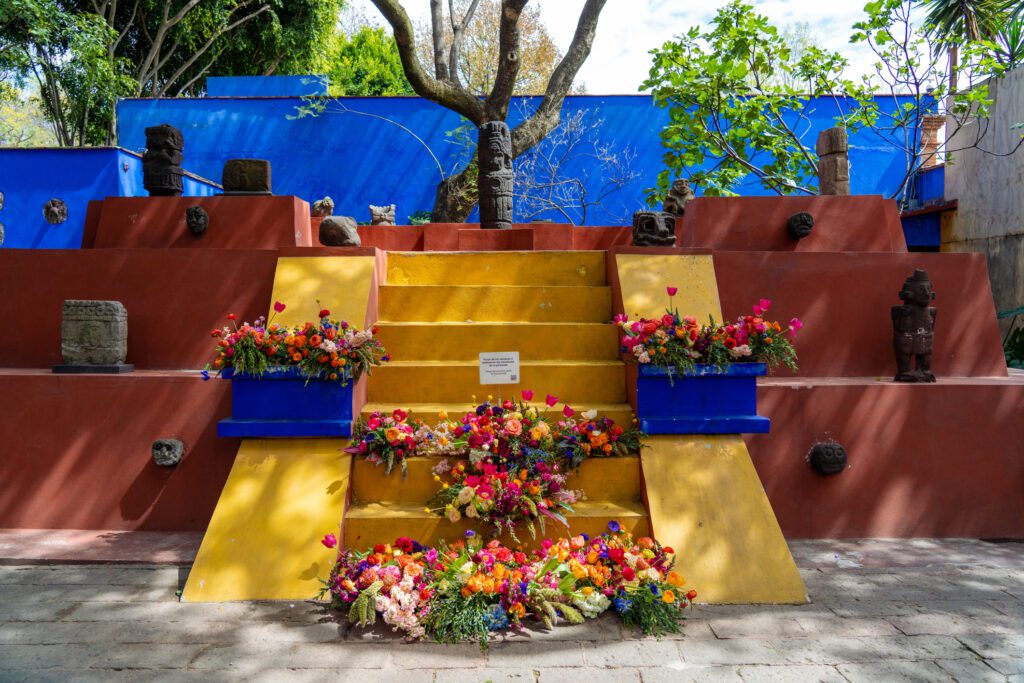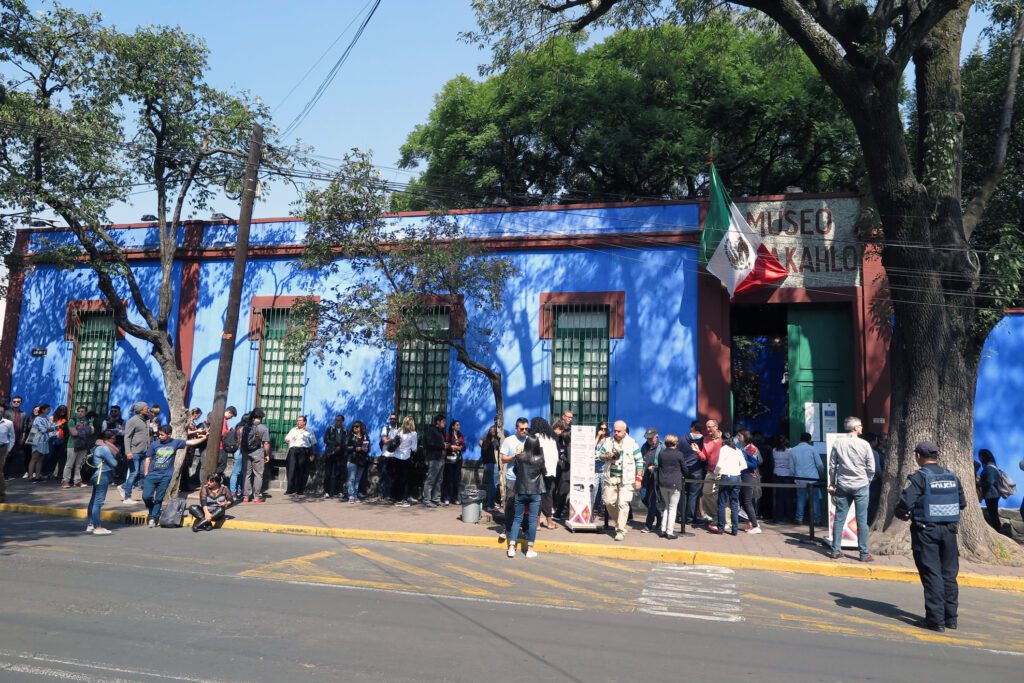
What Is La Casa Azul: The Home of Frida Kahlo?
La Casa Azul was a consistent anchor throughout Frida Kahlo’s life. She was born in the house, lived most of her life bedridden in its’ rooms, and then passed away upstairs.
The house in which a particular artist lived can tell us much about their personality, daily routine, and habits that have been kept under the public radar.
Therefore, transforming the artist’s house into a museum is not unusual. Frida Kahlo’s La Casa Azul, also known as the Blue House, is one of those captivating places. Visiting is a once-in-a-lifetime glimpse into the life of the Mexican artist’s life and practice.
Where Is la Casa Azul Located?
The iconic home can be found at Londres 247 and is known for its signature cobalt-blue walls. It was built at the beginning of the 20th century, and is located in the Colonia del Carmen neighborhood of Coyoacán in Mexico City. Since 1958, the Blue House has operated as the Frida Kahlo Museum.
The house was the home of Kahlo and her partner and fellow artist Diego Rivera. It was the epicenter of intellectual and Avant-Garde activity, where local and international figures gathered to exchange discourse.
History of la Casa Azul

The house was erected in 1904 on the lands that belonged to the former Hacienda del Carmen property. At that time, the Coyoacán neighborhood was part of the Federal District of Mexico City, but was very rural and separate from Mexico City’s urban life. Throughout the 1920s, Colonia del Carmen became populated by artists and intellectuals after the journalist Francisco Sosa promoted it.
Frida Kahlo was born in the house in 1907, which remained her family home. She met Diego Rivera while he was painting murals at the Secretaria de Educacion Publica building and summoned him to la Casa Azul to critique her artwork. As their relationship developed, Rivera became a regular visitor.
The Mexican power couple was not strangers to socialist ideologies. They were great supporters of Vladimir Lenin and his government, including one of his closest peers, Leon Trotsky.
After Lenin died, with the rise of Stalin, the political course of the Soviet Union changed significantly. Trotsky opposed Stalin and had to be exiled, eventually finding refuge in Mexico, where he and his wife spent two years at la Casa Azul in the late 1930s.
After Frida and Diego married, they left la Casa Azul and moved to the artist’s primary home in Mexico City and New York. Rivera did pay off the family’s mortgage on the home to secure that the house would remain in Frida’s possession.
In 1941, the couple relocated to la Casa Azul after the passing of Kahlo’s father, Guillermo Kahlo.
Starting in 1945, Frida was once again confined to bed in the house. From then to 1947, she painted works such as Flor de la Vida in 1945 and El sol de la Vida.
Frida died on the upper floor of this house on 13 July 1954 at the age of 47. Her wake took place there, before the body was taken to the Palacio de Bellas Artes and then cremated.
Four years after her death, in 1958, Rivera donated the house to the nation of Mexico and set up a foundation for its preservation. The house was converted to a museum dedicated to the life and works of Kahlo.
The museum was relatively obscure for many years as Frida Kahlo was little known beyond the art world until the 1990s.it wasn’t until a resurgence in interest Mexican art occurred which propelled Kahlo to become the iconic figure in pop culture she is known for today.
Design of la Casa Azul

The architecture is unique for the neighborhood as it was originally created in 1904 in a French style, but was adapted by Rivera and Kahlo in 1941 following the death of Kahlo’s father. It was altered to have a bigger garden and brighter colors such as the blue painted walls, which can be seen today.
Rivera constructed the wing which faces Londres Street and encloses the courtyard completely. This section was built of local volcanic rock, with ceramic vases set into it.
Frida’s studio and bedroom were moved there. To separate the new from the old, a stone wall divides the patio area in two, in front of which is a fountain, a stepped pyramid and other pre-Columbian artifacts, a reflection pool and a room for the couple’s archeological collection.
Juan O’Gorman did the redesign work on the house in 1946.
What Is the Significance of la Casa Azul to Frida Kahlo
As Kahlo’s birthplace, childhood residence, and place of death, La Casa Azul played a prominent role in the artist’s life.
Due to her health complications, Frida spent a considerable amount of her life confined to la Casa Azul, with her only outlet of grief being her art. She would often paint while bedridden.
The home would go on to become the artist’s studio through her marriage and separation from Rivera. Some of her most influential paintings were completed in the upstairs studio, including The Two Fridas and Self Portrait With Thorn Necklace and Hummingbird.
The Museum Collection
The house, which became the Museo Frida Kahlo, contains many of Kahlo’s paintings and works by other artists from her personal collection. Presenting Frida Kahlo as a person and as a much-loved and revered artist, the house is maintained similarly to how it was kept in the 1950s.
In addition to her works, the museumit contains a collection of artwork by Diego Rivera and other artists, along with the couple’s Mexican folk art, pre-Hispanic artifacts, photographs, memorabilia, personal items, and more.
The museum consists of ten rooms. On the ground floor is a room that contains some of Kahlo’s mostly minor works, such as Retrato de Guillermo Kahlo, 1952, El Marxismo Dará Salud, 1954 (showing Frida throwing away her crutches), with a watercolor Diario de Frida in the center.
The second and third rooms are dedicated to personal effects and mementos and to some of Rivera’s works. The second room is filled with everyday items Frida used, letters, photographs and notes. On the walls are pre-Hispanic necklaces and folk dresses, especially the Tehuana-style ones that were Frida’s trademark.
The fourth room contains contemporary paintings by artists such as Paul Klee, José María Velasco, Joaquín Clausel, Celia Calderón Orozco and a sculpture by Mardonio Magaña. The fifth room contains two large Judas figures, “mujeres bonitos” from Tlatilco, and figures from the Teotihuacan culture,a culture Kahlo would depict in her art.
The large papier-mâché Judas figures and other papier-mâché monsters were traditionally filled with firecrackers, exploded on the Saturday before Easter, and are prominent artifacts in Mexican culture.
The two rooms on the upper floor, open to the public, contain Frida’s final bedroom and studio area. This is located in the wing that Rivera had built. The original furniture is still there. In one corner, her ashes are displayed in an urn, surrounded by a funeral mask, some personal items, and mirrors on the ceiling.
On her bed is a painted plaster corset she was forced to wear to support her damaged spine, and under the canopy is a mirror facing down, which she used to paint her many self-portraits.
How to Vist la Casa Azul

The museum solely profits from ticket sales and visitor donations, so this structure of art history must continue to operate through tourism.
Tickets can be purchased through the museum website, along with private tours.
Standard hours are:
- Monday: closed
- Tuesday: 10:00 – 18:00
- Wednesday: 11:00 – 18:00
- Thursday to Sunday: 10:00 – 18:00
Special Hours are on these dates as follows:
- September 15: 10:00 – 14:00
- December 24 and 31: 10:00 – 14:00
And the museum is closed on these dates:
- January 1
- May 1
- September
- December 14 and 25
Final Thoughts
Today, la Casa Azul is one of the most visited museums in Mexico City. Thousands flock there every year to look into the extraordinary life of one of the most celebrated artists of all time.
Wherever she went, her presence was felt, and even in death during her cremation ceremony, observers claimed to see her smile slightly as her last wish to have her body burned was granted.